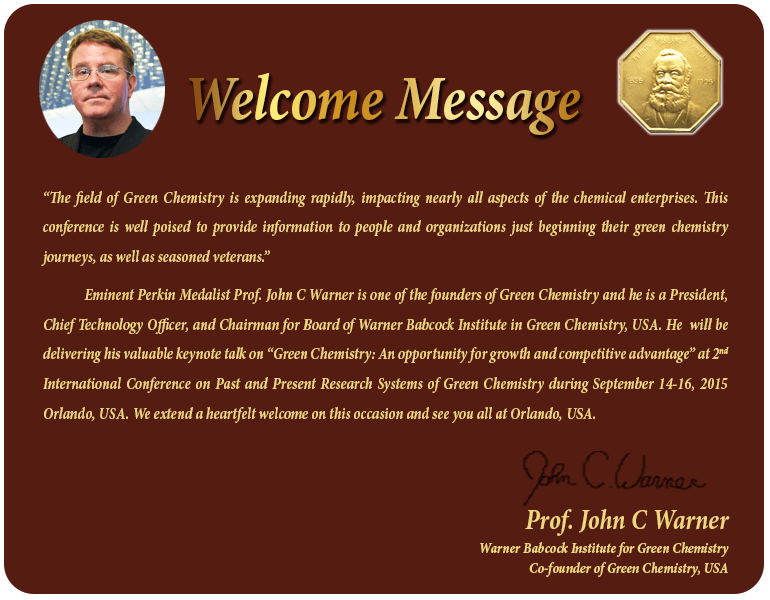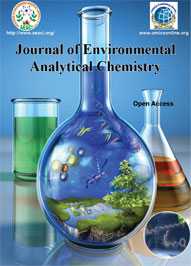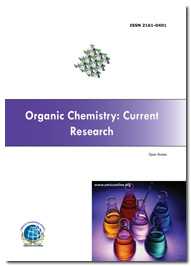2nd International Conference on Past & Present Research Systems of Green Chemistry “is going to be held in the month of September 14-16, 2015 at Orlando, USA organized by Conference Series LLC Ltd Conferences. The scientific program and workshops will focus on current advances in the research and use of Green Chemistry with the whole concept of this advanced technology is to agendize from past, analyze the present and implement for the future the latest innovative evolving theories and technologies to surpass the hurdles and make modish frontiers. Conference Series LLC Ltd Organizes 300+ Conferences Every Year across USA, Europe & Asia with support from 1000 more scientific societies and Publishes 500+ Open access journals which contains over 30000 eminent personalities, reputed scientists as editorial board members. To know more about the Conference Series LLC Ltd visit: http://www.conferenceseries.com/
Green Chemistry Conference will be a multidisciplinary gathering and present major areas such as green synthesis, green catalysis, education and policies. The forum of Scientists, students and researchers from all corners of the globe, come together to discuss future science. Each session of the meeting will be included with expert lectures, poster and discussions, join us to design sustainable development processes, innovations by which and how these strategies drive new policies, advances the business and human health protection. We are glad to invite you on behalf of organizing committee to join us, where you are the decision maker for future.
The global chemical industry is expected to grow from $4 trillion to $5.3 trillion by 2020. According to a 2011 report from Pike Research, Green Chemistry represents a market opportunity that will grow dramatically from $2.8 billion in 2011 to $98.5 billion by 2020. The same report also estimates that Green Chemistry is forecast to save industry $65.5 billion by 2020. a part of the $5.3 trillion US chemical industry.
Track 1: Basic Principles and New Trends in Green Chemistry
Sustainable and Green Chemistry in very simple terms is just a different way of thinking about how chemistry and chemical engineering can be done. Over the years different principles have been proposed that can be used when thinking about the design, development and implementation of chemical products and processes. These principles enable scientists and engineers to protect and benefit the economy, people and the planet by finding creative and innovative ways to reduce waste, conserve energy, and discover replacements for hazardous substances.
Green chemistry can also be defined through the use of metrics. While a unified set of metrics has not been established, many ways to quantify greener processes and products have been proposed. These metrics include ones for mass, energy, hazardous substance reduction or elimination, and life cycle environmental impacts.
“Green Chemistry is the utilization of a set of principles that reduces or eliminates the use or generation of hazardous substances in the design, manufacture and applications of chemical products”.
Principles of Green Chemistry:
1. Prevention
2. Atom Economy
3. Less Hazardous Chemical Syntheses
4. Designing Safer Chemicals
5. Safer Solvents and Auxiliaries
6. Design for Energy Efficiency
7. Use of Renewable Feedstocks
8. Reduce Derivatives
9. Catalysis
10. Design for Degradation
11. Real-time analysis for Pollution Prevention
12. Inherently Safer Chemistry for Accident Prevention
Track 2: Green Chemistry Applications
In 2005, the Nobel Prize in chemistry was awarded for the discovery of a catalytic chemical process called metathesis – which has broad applicability in the chemical industry. It uses significantly less energy and has the potential to reduce greenhouse gas emissions for many key processes. The process is stable at normal temperatures and pressures, can be used in combination with greener solvents, and is likely to produce less hazardous waste.
In 2012, Elevance Renewable Sciences won the Presidential Green Chemistry Challenge Award by using metathesis to break down natural oils and recombine the fragments into high-performance chemicals. The company makes specialty chemicals for many uses, such as highly concentrated cold-water detergents that provide better cleaning with reduced energy costs.
-
Industrial processes
-
Materials and applications
-
Basic chemicals
-
Polymers
-
Metals
-
Antibacterial Products
-
Laundry
-
Water Purification
-
Industrial Cleaning
Track 3: Green Synthesis-Designing the Starting Materials
There is currently considerable interest in applying the principles of green chemistry and sustainability to industrial organic synthesis, particularly in the fine chemicals and pharmaceuticals industries.
In any synthesis of a target molecule, the starting materials that are made to react with a reagent under appropriate conditions. Before coming to a final decision, consider all the possible methods that can give the desired product. The same product can also be obtained by modifying the conditions. The method of choice should not use toxic starting materials and should eliminate by-products and wastes. Following are some of the important considerations.
Track 4: Green Catalysts
Catalysts can be divided into two main types - heterogeneous and homogeneous. In a heterogeneous reaction, the catalyst is in a different phase from the reactants. In a homogeneous reaction, the catalyst is in the same phase as the reactants.
You might wonder why phase differs from the term physical state (solid, liquid or gas). It includes solids, liquids and gases, but is actually a bit more general. It can also apply to two liquids (oil and water, for example) which don't dissolve in each other. You could see the boundary between the two liquids.
Heterogeneous catalysis: This involves the use of a catalyst in a different phase from the reactants. Typical examples involve a solid catalyst with the reactants as either liquids or gases.
Homogeneous catalysis: This has the catalyst in the same phase as the reactants. Typically everything will be present as a gas or contained in a single liquid phase.
Track 5: Green Chemical Solvents
The use of hazardous and toxic solvents in chemical laboratories and the chemical industry is considered a very important problem for the health and safety of workers and environmental pollution. Green Chemistry aims to change the use of toxic solvents with greener alternatives, with replacement and synthetic techniques, separation and purification which do not need the use of solvents.
One of principles of Green Chemistry is to promote the idea of “greener” solvents (non-toxic, benign to environment), replacement in cases that can be substituted with safer alternatives, or changes in the methodologies of organic synthesis, when solvents are not needed.
Track 6: Green Metrics and Measurements
Quantifying the environmental impact of chemical technologies and products, and comparing alternative products and technologies in terms of their “greenness” is a challenging task. In order to characterise various aspects of a complex phenomenon, a number of different indicators are selected into a metric. Green Chemsirty conference outlines fundamental developments in chemistry and chemical technology that have led to the development of green chemistry, green chemical technology, and sustainable chemical technology concepts, and provide a foundation for the development of the corresponding metrics. It includes different approaches to metrics, and case study examples of their applications, and problems in practice.
Track 7: New Ideas for Non Toxic By-Products
Clean technology includes recycling, renewable energy (wind power, solar power, biomass, hydropower, biofuels, etc.), information technology, green transportation, electric motors, green chemistry, lighting, Greywater, and many other appliances that are now more energy efficient. It is a means to create electricity and fuels, with a smaller environmental footprint and minimise pollution. To make green buildings, transport and infrastructure both more energy efficient and environmentally benign. Environmental finance is a method by which new clean technology projects that have proven that they are "additional" or "beyond business as usual" can obtain financing through the generation of carbon credits. A project that is developed with concern for climate change mitigation (such as a Kyoto Clean Development Mechanism project) is also known as a carbon project.
Track 8: Organic Synthesis based on multiphase operation
Organic synthesis is a special branch of chemical synthesis and is concerned with the construction of organic compounds via organic reactions. Organic molecules often contain a higher level of complexity than purely inorganic compounds, so that the synthesis of organic compounds has developed into one of the most important branches of organic chemistry. There are several main areas of research within the general area of organic synthesis: total synthesis, semisynthesis, and methodology.
A total synthesis is the complete chemical synthesis of complex organic molecules from simple, commercially available (petrochemical) or natural precursors. Total synthesis may be accomplished either via a linear or convergent approach. In a linear synthesis—often adequate for simple structures—several steps are performed one after another until the molecule is complete. The chemical compounds made in each step are called synthetic intermediates. For more complex molecules, a different approach may be preferable: convergent synthesis involves the individual preparation of several "pieces" (key intermediates), which are then combined to form the desired product.
Track 9: Industrial Applications of Green Chemistry
In the past, the industrial production of Adipic acid used benzene as a starting material. Benzene is one of the basic chemicals for industrial reactions and a solvent. It is known that derives mainly from the refining processes of the petrochemical industry. Benzene is also known for its carcinogenic properties (it causes leukemia to highly exposed workers). Afterwards the starting material became cyclohexanone or a mixture of cyclohexanone and cyclohexanol. For the oxidation process it was used nitric acid, producing toxic fumes of nitric oxides, NOx, which are also contributors to the greenhouse effect and the destruction of the ozone layer in the strat osphere. It was Inevitable that the method had to be changed again with more environmentally benign reactions.
Track 10: Analytical Methodologies
An analytical method or analytical technique is a method to determine the concentration of a chemical compound or element in a sample. There is a very wide variety of methods used for analysis which afford different degrees of sample preparation and instrumentation
Track 11: Sustainability and Environmental Safety
At the global scale and in the broadest sense sustainability and environmental safety management involves managing the oceans, freshwater systems, land and atmosphere, according to sustainability principles.
Land use change is fundamental to the operations of the biosphere because alterations in the relative proportions of land dedicated to urbanization, agriculture, forest, woodland, grassland and pasture have a marked effect on the global water, carbon and nitrogen biogeochemical cycles. Management of the Earth's atmosphere involves assessment of all aspects of the carbon cycle to identify opportunities to address human-induced climate change and this has become a major focus of scientific research because of the potential catastrophic effects on biodiversity and human communities. Ocean circulation patterns have a strong influence on climate and weather and, in turn, the food supply of both humans and other organisms.
Track 12: Green Chemistry and Engineering
Green engineering approaches the design of products and processes by applying financially and technologically feasible processes and products in a manner that simultaneously decreases the amount of pollution that is generated by a source, minimizes exposures to potential hazards (including reducing toxicity and improved uses of matter and energy throughout the life cycle of the product and processes). In so doing, the overall health and ecological stress and risk are reduced. As such, green engineering is not actually an engineering discipline in itself, but an overarching engineering framework for all design disciplines.




















